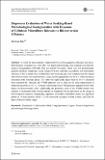Bioprocess Evaluation of Water Soaking-Based Microbiological Biodegradation with Exposure of Cellulosic Microfibers Relevant to Bioconversion Efficiency
Author(s)
Bak, Jin Seop
Download12010_2015_Article_1718.pdf (1.762Mb)
PUBLISHER_POLICY
Publisher Policy
Article is made available in accordance with the publisher's policy and may be subject to US copyright law. Please refer to the publisher's site for terms of use.
Terms of use
Metadata
Show full item recordAbstract
To verify the interconnective relationship between biodegradation efficiency and microfibril structure, recalcitrant rice straw (RS) was depolymerized using water soaking-based microbiological biodegradation (WSMB). This eco-friendly biosystem, which does not predominantly generate inhibitory metabolites, could increase both the hydrolytic accessibility and fermentation efficiency of RS. In detail, when swollen RS (with Fenton cascades) was simultaneously bio-treated with Phanerochaete chrysosporium for 12 days, the biodegradability was 65.0 % of the theoretical maximum at the stationary phase. This value was significantly higher than the 30.3 % measured from untreated RS. Similarly, the WSMB platform had an effect on the yield enhancement of ethanol productivity of 32.5 %. However, uniform exposure of fibril polymers appeared to have little impact on bioconversion yields. Additionally, the proteomic pools of the WSMB system were analyzed to understand either substrate-specific or nonspecific biocascades based on the change in microcomposite materials. Remarkably, regardless of modified microfibril chains, the significant pattern of 14 major proteins (|fold| > 2) was reasonably analogous in both systems, especially for lignocellulolysis-related targets.
Date issued
2015-06Department
Massachusetts Institute of Technology. Department of Chemical EngineeringJournal
Applied Biochemistry and Biotechnology
Publisher
Springer US
Citation
Bak, Jin Seop. “Bioprocess Evaluation of Water Soaking-Based Microbiological Biodegradation with Exposure of Cellulosic Microfibers Relevant to Bioconversion Efficiency.” Applied Biochemistry and Biotechnology 176, no. 8 (June 28, 2015): 2290–2302.
Version: Author's final manuscript
ISSN
0273-2289
1559-0291